Western Digital VelociRaptor 1TB (WD1000DHTZ) Review
by Anand Lal Shimpi on April 16, 2012 8:00 AM EST- Posted in
- Storage
- HDDs
- Western Digital
- VelociRaptor
Random Write Speed
The VelociRaptor's two primary strengths are its 2.5" platter size and 10,000 RPM spindle speed. The combination of the two delivers some of the best random access times you can get from a mechanical hard drive, at least one aimed at the desktop. Indeed we see a tangible performance advantage not only over the latest 3.5" hard drives, but also the previous generation VR. The advantage of the NAND equipped Seagate Momentus XT is just as large.
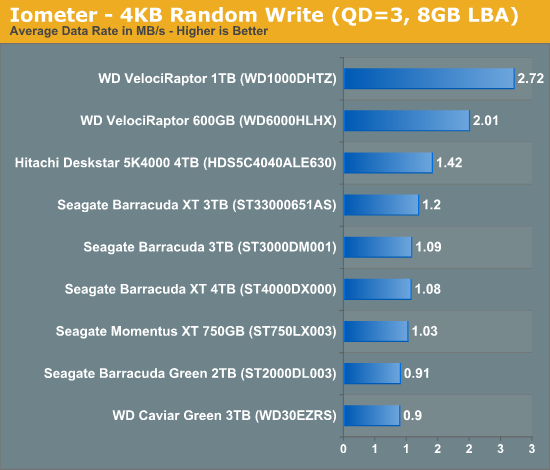
Obviously even the most affordable SSDs deliver better random IO performance compared to the VelociRaptor as you can see by looking at Intel's SSD 320 here:
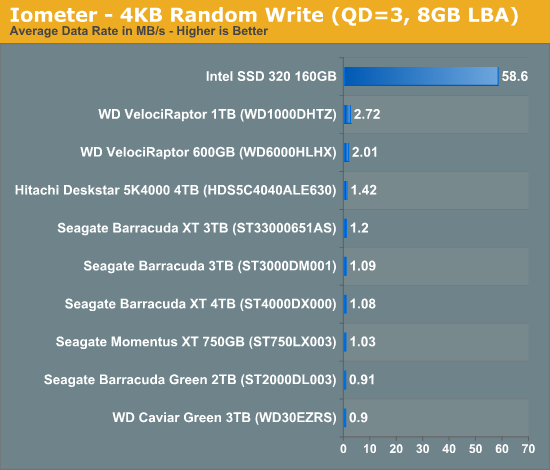
The new VelociRaptor manages a 35% increase in 4KB random write performance over its predecessor, and more than double the performance of Seagate's 7200RPM Barracuda XT. Unlike SSDs, random read and write performance is symmetric on most hard drives so we only really need to look at a single value here. Intel's SSD controllers have typically offered very high random IO performance, so the SSD advantage here isn't unusual.
Ultimately it's this 21x gap in random IO performance that really contributes to why SSDs feel so much faster than mechanical drives. Client workloads aren't purely random in nature (which is why we confine our client random write tests to an 8GB LBA space), but sprinkle non-sequential accesses in the middle of otherwise sequential transfers and mechanical disk performance drops significantly. Small file requests while launching an application, updating file tables, writing to logs, are all examples of small, pseudo-random IO that happen in the background, which can make overall HDD performance drop significantly. While it's true that most client workloads don't require the sort of random IO performance a high-end SSD can provide, it's the additional headroom that SSDs offer that allow performance to remain high regardless of what's going on in the background. We can look at this data another way, instead of average data rate let's look at the maximum number of IO operations these drives can service in a single second:
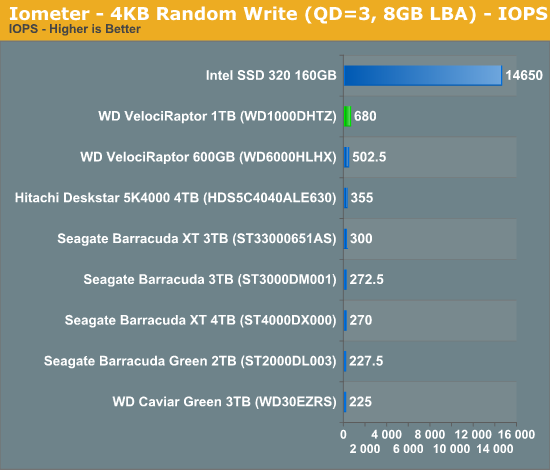
Based on this list, the average hard drive (excluding WD's 10,000 RPM drives) is capable of handling around 275 4KB pseudo-random write operations per second. Clearly that's not sufficient for the majority of client workloads because once you load up full disk encryption, real time virus checking, background email/IM, backup software and go about your normal application usage you always run into IO limited periods where you're waiting on your drive to finish crunching. Upping the spindle speed to 10,000 RPM gives you a bit of a reprieve, more than doubling performance, but that's not always sufficient given the workload.
At the other end of the spectrum we have a stanard 3Gbps SSD, capable of servicing nearly 15,000 4KB write operations per second. No desktop application could be shipped that required this type of IO performance as it would be unusable on any hard drive. The added performance in the case of an SSD doesn't deliver 21x the performance of a VelociRaptor, but it offers enough performance headroom that applications and file accesses will remain as fast as possible regardless of what's going on in the background. SSDs use their headroom to offer a consistent IO experience, regardless of workload.
Sequential Read/Write Speed
Sequential performance is easily improved by increasing platter density, buffer sizes and pushing for more aggressive prefetch in the drive's controller. As a result, the SSD advantage isn't nearly as significant. Furthermore, the new VelociRaptor delivers such a large increase in sequential speed that it's able to approach the performance of 3Gbps SSDs:
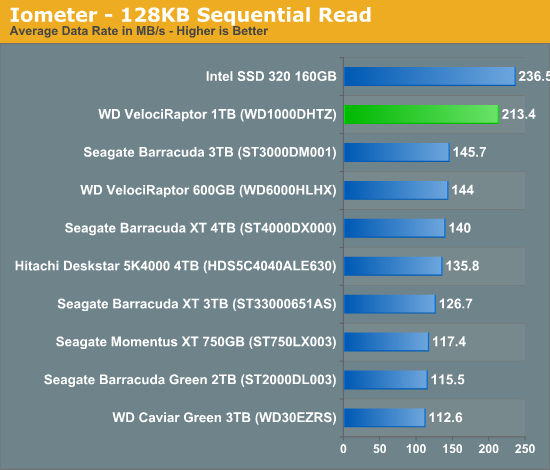
It's because so much of client workloads are sequential in nature that some users don't really feel a dramatic difference in going from a hard drive to an SSD. The only thing I can add is that the users who are constantly frustrated by the speed of their hard drive will be the ones to most appreciate the move to solid state storage. Shifting focus back to the VelociRaptor however, its sequential read speed is quite competitive with mainstream 3Gbps SSDs. Start comparing to 6Gbps drives and the VR is significantly outgunned.
Again, reads and writes don't vary with the VR but compared to the 160GB Intel SSD 320 there's a shift in the standings:
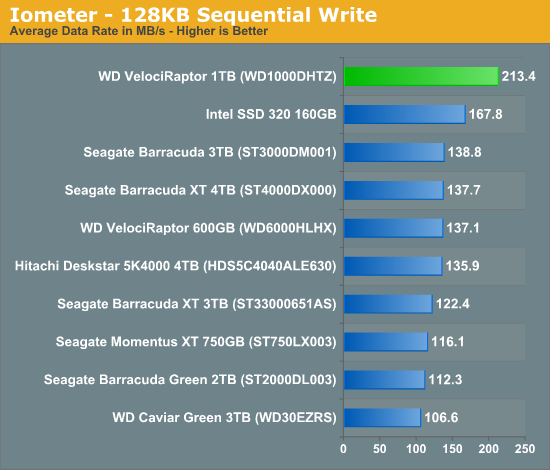
Again, compared to larger or faster SSDs the VelociRaptor would surely lose, I tried to pick an SSD that was more representative of what you could get on a budget or with an older drive. Either way the gains over other mechanical drives are respectable, the new VR definitely delivers in sequential speeds as far as hard drives are concerned.
Performance Across All LBAs
Although logical block addressing works linearly, hard drives are made up of one or more circular platters. Platters are written from the outside inward in order to maximize performance (you cover more data in a single rotation of an outer track vs an inner track). I used HDTach to characterize the new VelociRaptor's performance across all LBAs:
The inner most tracks on the VelociRaptor are still accessible at 123MB/s - faster than any 3.5" drive we've tested here. One benefit to using 2.5" platters is remarkably consistent performance across all tracks. Average performance across all tracks is 173MB/s.


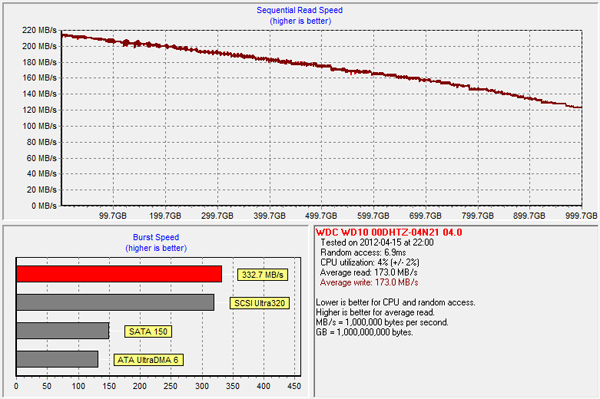








92 Comments
View All Comments
c4v3man - Monday, April 16, 2012 - link
Exactly. Dell offers these drives in their workstation lineup, and I think at one point offered them in their 100-300 series servers. It would be great if Anand would compare the drive to a modern 10K SAS drive, to see how close the two technologies are nowadays.That being said, 600GB 15K SAS drives are under $500 I believe from Dell, so it would only make sense as mass storage.
dananski - Monday, April 16, 2012 - link
I think you're on to something there - SAS drives are getting expensive enough that you start to think about SSDs, so maybe these would fill that big price gap between standard and enterprise drives.Would be pretty good for some other situations too. Games, video editing, music production and image editing need space and sequential speed and this gives both those things at a lower budget than an SSD.
shin0bi272 - Monday, April 16, 2012 - link
What surprised me about this is that they didnt try pushing it to 15k rpm. Some nand would have helped too but as you said in the opening paragraphs... about the only way you can increase speed in a spindle disk is to increase rotational speed or area density. So why not do both? Not sure if they use perpendicular recording on these or not but that would be another way to increase the density and the speed.Of course the down side is that not only is nand still MUCH faster and getting cheaper by the day but, we also have PCM drives coming (hopefully) soon which is 100x faster than flash and lasts for millions of write cycles rather than thousands... Unless its $1000 per gig for the next 10 years who's going to buy a spinning disk when its 10,000X slower than a pcm drive?
Stahn Aileron - Monday, April 16, 2012 - link
Last I recall, bumping up the spindle speed would counteract the areal density increase. Every time I see a spindle speed bump across drives in a similar price bracket, the capacity goes down. I'm guessing it has to do with how quickly the heads can actually read the data under them before its move out from under them. (Perhaps ECC as well.)Still, the last time I saw a 15k RPM drive, the max capacity I think was around 320GB or so. I can't say for certain now as I don't track 15k RPM drives. I don't have the need for enterprise-grade HDDs of that performance. (And to be honest, most storage coverage these days is about SSDs. HDDs don't get into the news much except for the ocassional model revision, if that.)
piroroadkill - Monday, April 16, 2012 - link
I have some 600GB 15K SAS drives right here.Stahn Aileron - Monday, April 16, 2012 - link
Well, like I said, it;s been a while since I bother to look at 15k drives, even in passing, much less recall the numbers. On the other hand, 15k 600GB SAS drives do sound/look familiar. Still, that's the upper end of the capacity spectrum for 15k drives right now, no?shin0bi272 - Tuesday, April 17, 2012 - link
actually I feel you on the not paying attention to 15k drives. That's kinda why I was hoping WD was going to push their Vraptors faster and maybe keep the size around 300-500gb... They are usually so expensive that individuals arent even aware they exist. WD could have changed that but they didnt. They could have made huge changes to the slowly dying spinning disk market... but they didnt. They just increased the size of their current 10krpm drive.Dont get me wrong a 10krpm 1tb drive is cool (especially for the price) but no one needs this drive in their home. A gamer will have an SSD and a plain old drive for storage to keep their files on. A graphic designer might do the same. And people who dont need the performance of an SSD (like lets say my dad) just throw in a 7200rpm drive and call it close.
But yeah no one does reviews of spinning disk anymore because they are becoming obsolete pretty quickly with the falling costs of SSDs (even in the enterprise market) and like I said originally PCM drives.
shin0bi272 - Tuesday, April 17, 2012 - link
http://gizmodo.com/5808353/solid-state-drives-are-...Arnulf - Monday, April 16, 2012 - link
"... the only 3.5" hard drive with a 10,000 RPM spindle speed ..."There have been many real 3.5" drives with 10K (and higher) spindle speed before WD's (Veloci)raptors. It wasn't WD who changed anything, they merely copied what other manufacturers have done years before them.
While others manufacturers went to 15K for performance drives WD is still stuck in 1990s with everything but recording density.
Stahn Aileron - Monday, April 16, 2012 - link
I think Anand means at the consumer level. All 10k and 15k drive other than the VR from WD are aimed solely at enterprise. They are engineered/marketed as such from what little exposure I have of that market space. In all the time I've been into computer news (about a decade), the WD Raptor and VelociRaptor line were/are the only consumer-level 10k RPM drives. All other high performance drives in the consumer space have been 7200RPM drives. I don't ever recall seeing another 10k or 15k drive from any other manufacturer aimed at the consumer space (even if just at the enthusiast level.)